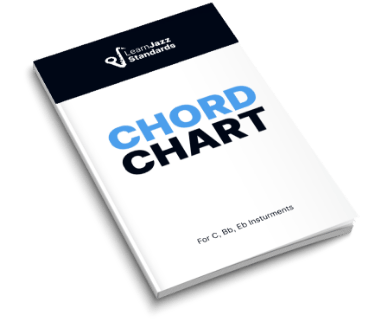No matter what instrument you play, there are fundamental aspects of jazz that every jazz musician needs to practice. However, there are also instrument-specific things you need to focus on to master jazz on your particular instrument.
All of these different aspects might seem overwhelming, but with the right bite-by-bite approach, you can make massive progress.
So what’s in today’s bite?
This post will focus on the instrument-specific things you need to practice to master jazz on the saxophone. We’ll explore the tactics that the best jazz saxophonists employ to master the technical side of jazz saxophone.
These tips will work whether you are an alto saxophonist, tenor saxophonist, or any saxophonist!
In this jazz saxophone primer, we’ll:
- Help you overhaul your jazz saxophone practice habits to help you overcome roadblocks in your jazz saxophone playing.
- Help you understand the sax better so you can play it with more confidence and authority.
- Help you build your defining jazz saxophone sound through various tonguing and articulation techniques.
- Provide guidance on what to shed to improve your jazz musicianship and music theory knowledge.
What’s separating your playing from that of the jazz greats? It’s time and process.
You will see measurable improvements in your saxophone tone, keyboard technique, and jazz knowledge with the right strategy.
This post will get you started on the right foot and set you off on your journey toward jazz music mastery. If you like what you read and are ready to begin the next level, check out the Learn Jazz Standards Inner Circle.
You’ll not only gain access to over a decade of accumulated jazz education courses, videos, masterclasses, and jazz standard studies, but you’ll also gain access to the Jazz Saxophone Accelerator course, which is designed to help beginner and intermediate saxophone players get to the next level.
Ready to accelerate your jazz saxophone playing and join the ranks of the best jazz saxophonists?
Come see what the Inner Circle has to offer.
How To Develop a Good Jazz Saxophone Tone in 3 Steps
Saxophone tone is a key factor separating professional-sounding sax players from amateur-sounding saxophone players. If you only focus on the mechanical aspects of playing saxophone, you’ll sound like a robot.
So much emotion and expression are conveyed through the voice of your sax. It’s integral to your musical identity as a jazz sax player.
1. It All Starts With the Mouthpiece
Whether you play soprano saxophone, alto saxophone, or tenor saxophone, most of your “sound” comes from how you interface with your mouthpiece. In fact, 90% of your tone comes down to your embouchure, lip pressure, jaw positioning, and tongue position.
Since all of these factors involve the mouthpiece, it makes sense that you’ll want to focus on the mouthpiece technique.

Experiment With Two Types of Embouchure
Saxophonists use two common types of embouchure:
- Jaw pressure embouchure: This embouchure is more common in classical playing but is also used by jazz saxophonists. It creates a dark, earthy tone compared to lip pressure embouchure. With jaw pressure embouchure, your lower lip stays relaxed and curls over your bottom teeth.
- Lip pressure embouchure: This is considered “jazz embouchure,” which has a characteristically brighter sound. With lip pressure embouchure, your lower lip must stick out past your lower teeth. Your lower lip needs to be firm, and the corners of your mouth held tight. Note: developing muscle strength and endurance for lip pressure embouchure can take several weeks of regular practice.
Jaw Pressure (Left) vs. Lip Pressure (Right):
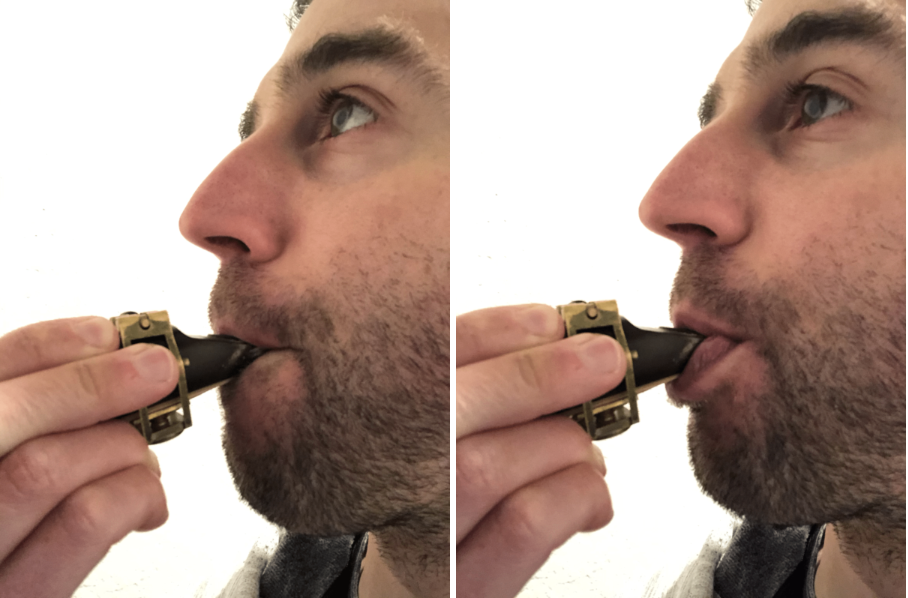
You should experiment with both types of embouchure. Many saxophonists don’t limit themselves to one or the other and instead take advantage of the tonal qualities of each to add more depth to their saxophone playing.
Mouthpiece Placement and Saxophone Tone
Where you position the mouthpiece has a profound influence on your saxophone tone.
Generally, regardless of the embouchure you are developing, you want your bottom lip to be in line with where the reed breaks away from the table of the mouthpiece (see mouthpiece diagram above).
Because lip pressure embouchure requires your lower lip to be extended, less of the mouthpiece should be in your mouth when practicing it compared to jaw pressure embouchure.
Jaw Position, Saxophone Tone, and Pitch
Where you place your jaw influences the tone and pitch of your saxophone.
Your jaw controls two important parameters of your saxophone sound:
- Tone or Timbre is controlled by moving your lower jaw forward and backward. Moving your jaw forward greatest a brighter tonal quality and offers more resistance. Moving your jaw backward creates a darker, warmer, earthier tonal quality and offers less resistance.
- Pitch is controlled by moving your lower jaw up and down. The more pressure you apply to the reed with your jaw (jaw up), the higher you can bend the pitch. The less pressure you apply with your jaw (jaw down), the lower you can bend the pitch. To maximize your range, starting somewhere in the middle makes sense.
Mouthpiece-Only Exercises To Build Strength, Endurance, and Control
Here are a few exercises you should do as part of your warm-up before attaching the mouthpiece to the saxophone (especially if you are trying to build strength and endurance).
Playing a full major or chromatic scale with only your mouthpiece is difficult! It should be a practice goal. Don’t be discouraged if building strength, control, and range takes time.
Long Tones Testing The Pitch Range of Your Mouthpiece
Try bending the pitch using both embouchures. As your strength and control increase, you can bend the pitch further in either direction. This also helps you find the right spot where you have a maximal range in both directions.
Playing a Diatonic Major Scale With Only Your Mouthpiece
This might take a while, so don’t be discouraged! After playing a long tone to the top of your mouthpiece range and back to the bottom, try to play a diatonic major scale using only your jaw/lip pressure. Aim for the first few intervals if a full scale is out of reach.
Playing a Chromatic Scale With Only Your Mouthpiece
The hardest exercise is playing a chromatic scale with only your mouthpiece. Isolating half steps requires intense precision and embouchure control.
2. Long Tones, Long Tones, Long Tones
Once you feel comfortable controlling the tone, timbre, and pitch on your mouthpiece, it’s time to bring that level of focus and dedication to the full sax. Jazz saxophonists know the best way to develop control and endurance on the full instrument is to get creative with long-tone practice.
Some jazz saxophonists want to skip this crucial part of saxophone development instead of other flashier things, but practicing long tones is something you should not skip. Musicians in the jazz scene can tell if a saxophonist has spent time practicing their long tones because a player’s long tone practice directly relates to their tone quality and endurance.
Get Meditative With Long Tones
You shouldn’t frame long-tone practice as another box to check or a means to an end. Instead, you should frame it as a meditative grounding exercise that helps you build a deeper, more intuitive connection with your saxophone.
Think about it—when you practice long tones, you already focus on breathing. That’s half of the battle. By framing the time you spend on long tones as a meditation session, you turn long-tone practice into an activity that not only helps your playing improve but also your mood and well-being.
Long Tone Practice Check-List
Now we know how to frame long-tone practice, but how should we actually do it?
There are several things you should consider when practicing long tones.
1. Frequency:
Ideally, you should practice long tones daily as a mental and physical warm-up. Doing so will keep your chops up and help you connect with your sax on a deeper level.
It is far better and more productive to practice every day for 10 minutes than once a week for 2 hours.
2. Variations:
Time is a limited resource, especially for adults trying to keep up with their love of music and jazz. As adult musicians, we need to get creative with how we practice so that we can cover as much ground as possible with our limited time.
While practicing long tones, you can also practice other important elements of jazz saxophone playing, such as dynamics and vibrato. Here is a long-tone/dynamics exercise you can use to practice long tones and dynamics at the same time:

Depending on how much time you have to practice, you should perform this exercise on at least a few pitches on your instrument daily. That way, after a few weeks, you’ll have practiced it on every pitch of your instrument.
How about a vibrato exercise? Long-tone practice also provides us a great opportunity to work on developing our tremulous vibrato. Before we get to the long-tone/vibrato exercise, here is a way to visualize your vibrato:
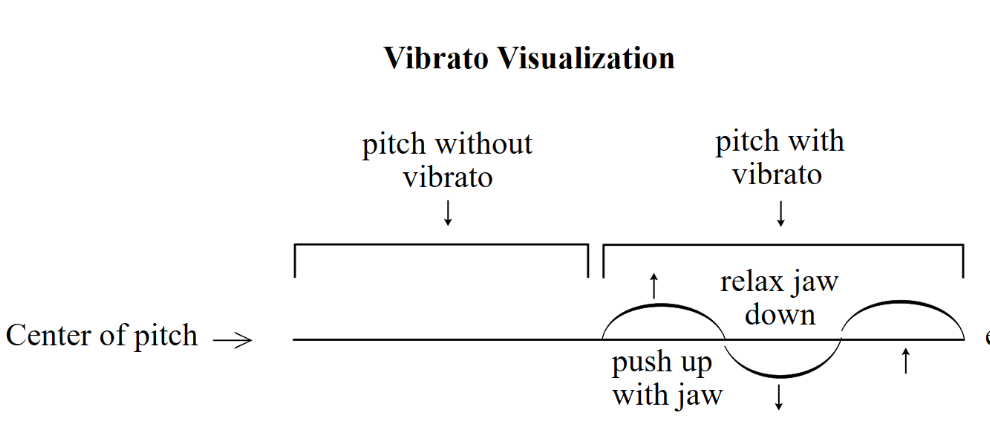
To create vibrato on any saxophone, you must use your jaw to bend the pitch.
- To raise the pitch, push up with your jaw on the reed
- To lower the pitch, relax your jaw down from the reed
- To maintain pitch, keep the pressure on the reed consistent
Let’s move on to the long-tone/vibrato exercise.

Try practicing your vibrato in time! Using a metronome set to a lower BPM, try subdividing the big beat into smaller and smaller subdivisions.
3. How To Handle Extreme Registers On Your Saxophone
Whether you favor tenor sax, alto sax, soprano, or baritone sax, you’ll know that playing in the extreme registers of each is more challenging than playing in the middle registers. The best jazz saxophonists have perfected their jazz sax tone at all instrument registers.
To effortlessly flow between different registers of your saxophone, you need to control several different parameters of your mouth when playing. All three parameters are important for playing at extreme registers.
1. Jaw Position
As mentioned earlier, your jaw position controls two parameters of the jazz sax: pitch and timbre. You should strive for consistent pitch/intonation and tone quality across all registers of the instrument.
If you struggle to learn jazz standards by ear, memorize them, and not get lost in the song form, then our free guide will completely change the way you learn tunes forever.BEFORE YOU CONTINUE…

2. Tongue Position or “Voicing”
Your tongue position affects the size of the opening at the back of your throat, which affects how much air you pass out of your mouth. The higher your tongue is, the faster air moves through. This airspeed influences your tone quality and intonation on the saxophone.
3. Air Support
How you breathe directly affects how much air you can push through the mouthpiece. When paired with the appropriate jaw position and voicing, breathing correctly will help you maintain consistent tone quality and intonation at various registers.
There isn’t one set combination of these parameters that will help you at all registers. You must think dynamically and practice manipulating these parameters to create your desired sound.
Here are some chromatic scale exercises to help you maintain consistency as you pass through all registers of your saxophone:

Jazz Saxophone Tonguing Techniques and Time Feel
Now that you have a grasp on how to develop your saxophone sound, we can shift focus to developing your time feel. The best jazz saxophonists (and the best jazz musicians in general) spend countless hours focusing on their mastery of time.
A jazz saxophonist’s time feel is created through the interplay between their tonguing articulations and their fingers. In this section, we will talk about how to practice tonguing articulations to develop a strong time feel. We’ll focus on fingerings in the next section.
Move Your Tongue, Not Your Mouth
When we use our tongue automatically, like when we talk, it is in conjunction with our jaw. Our jaw and tongue must work together to speak with clarity.
However, with jazz saxophone, our jaw and our tongue control different aspects of the saxophone’s sound, and our tongues are responsible for starting and stopping notes. Essentially, we need to train our tongue to work independently from our jaw in a way that feels unnatural (at first).
To make things more complicated, different parts of our tongue have different responsibilities when producing sound on the saxophone. Remember from the previous section that the back of the tongue controls our “voicing” and changes how fast or slow air moves out of our mouths.
This aspect of tongue control needs to be isolated from what the tip of the tongue does, which obstructs the flow of air through the mouthpiece to produce rests.
To sum up, you need to:
- Control your tongue independently from your jaw.
- Use the back of your tongue to control voicing and the tip of your tongue to control tonguing articulations.
Keep this in mind when practicing tonguing articulations!
How To Practice Tonguing Articulations
There are several articulations you need to master to play jazz saxophone effectively. Here are the two most important ones:
Legato:
Legato notes are long, smooth, and connected, with no breaks between them. Therefore, with legato tonguing, your airstream should never stop completely. The tip of your tongue should not abruptly stop the airflow. Rather, it should gently interrupt or impede it.
- Use the syllables “too,” “tea,” “tah,” or “tuh” to help perfect the articulation.
Staccato:
Staccato notes are abrupt and disconnected. There are two staccato articulations for jazz saxophone, and each articulation should result in a space or silence between the notes. The big difference is how this silence is produced.
For jazz staccato, use the tip of the tongue to choke off the airflow to the mouthpiece briefly.
- Use the syllable “tut” to clip the sound
For classical staccato, don’t use your tongue to stop the sound. Instead, stop the airflow by closing the back of your throat.
- Use the syllable “tah” and stop the flow of air
When practicing these articulations, keep in mind that only the tip of your tongue should contact the very tip of the reed:
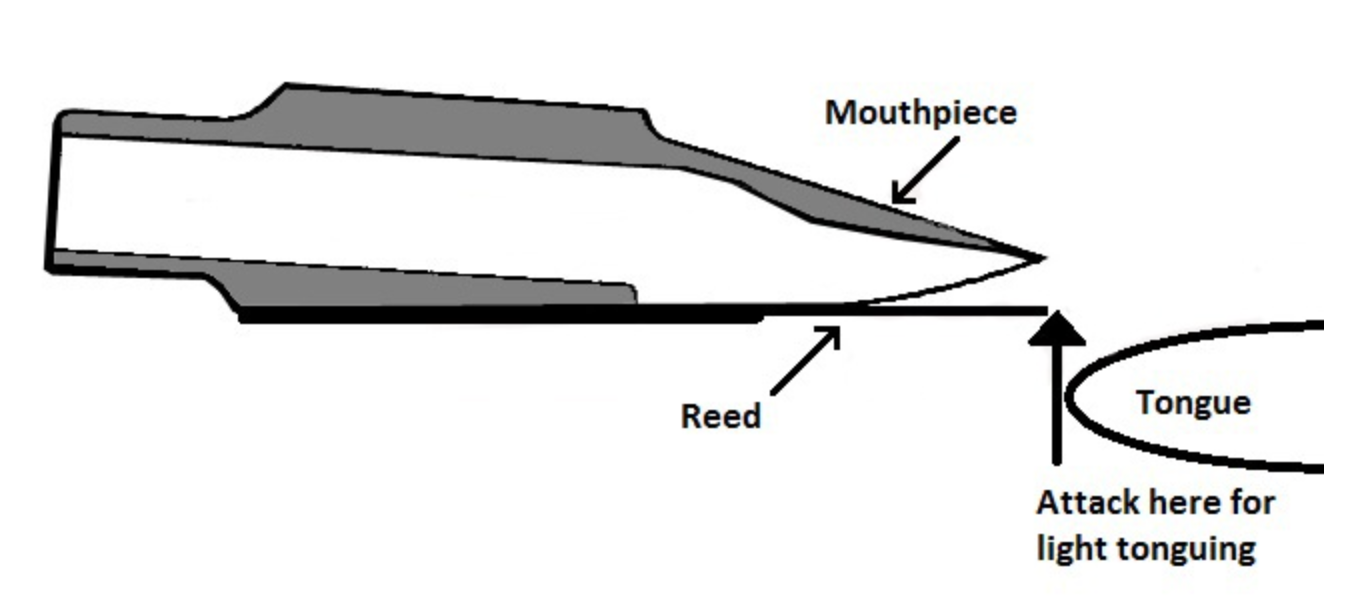
Tonguing Articulations Exercises
Remember the best practices we’ve covered in earlier sections for the following exercises!
- Tongue lightly with the utmost tip of the tongue. Aim to contact the very tip of the reed.
- Isolate the tip of your tongue from the back of the tongue, as both have separate functions.
- Keep the back of the tongue high to create narrow voicing so that air moves faster through the mouthpiece and the tip of the tongue is closer to the tip of the reed.
- Don’t allow your tonging to affect your embouchure and jaw position!
For best practices, be sure to try all the following exercises
- With straight 8th-notes and with a swing 8th-note feel
- With and without a metronome at various tempos
Try Legato and Staccato articulations on various rhythms using one pitch:

Five-note scale groupings to practice articulations on more than one pitch:
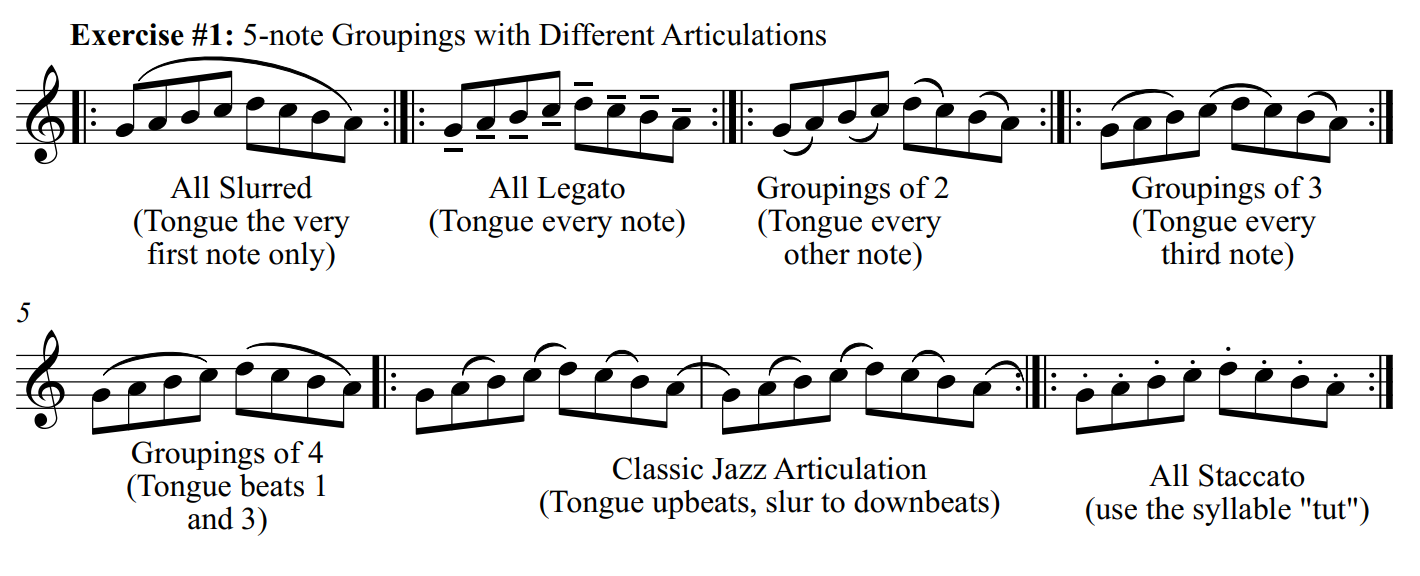
Full-octave scales to practice articulations:
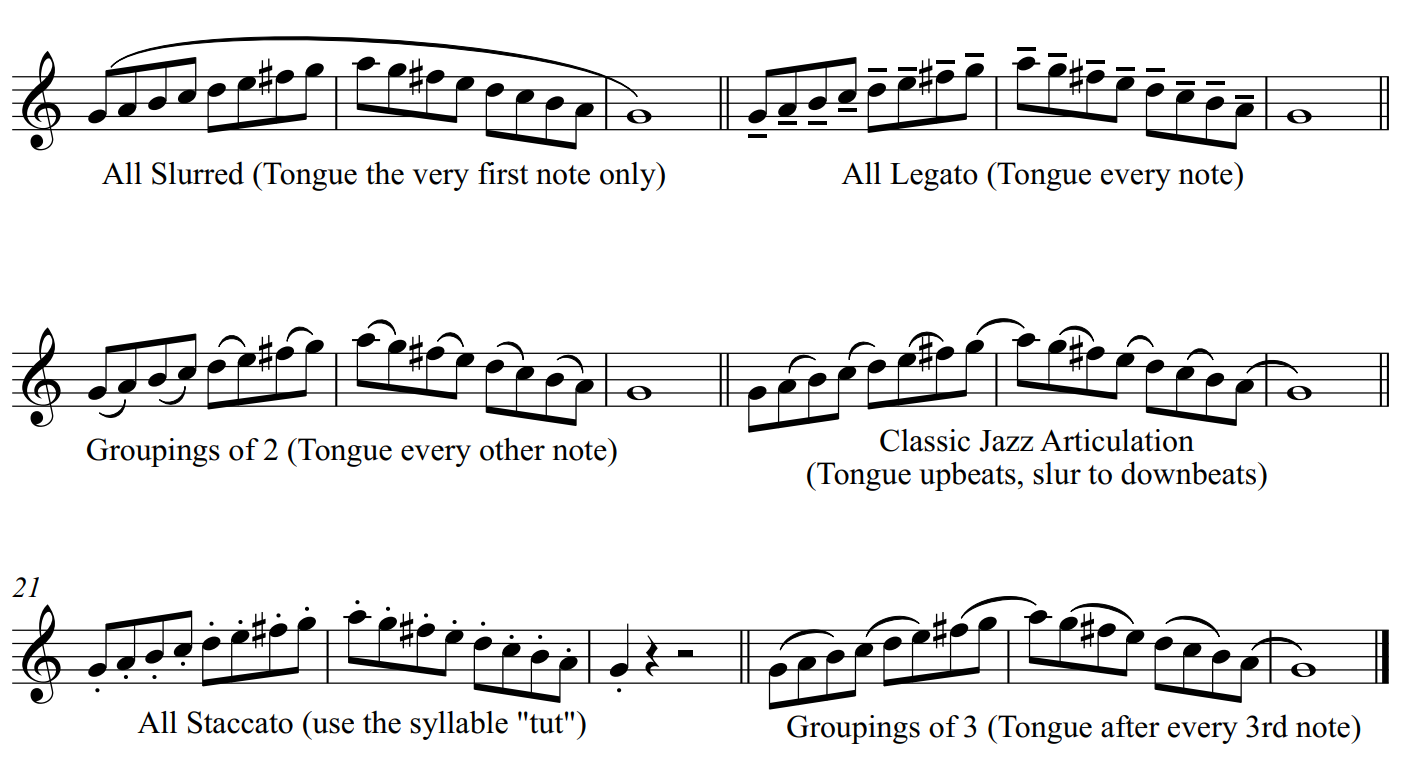
Jazz Saxophone Finger Techniques
Let’s focus on the other crucial aspect of jazz saxophone time feel—your fingers!
The best jazz saxophonists have spent hours optimizing the best way to approach playing the saxophone keyboard. Though each jazz saxophonist will have a slightly different approach, there are some general best practices you should internalize when focusing on this aspect of your playing.
Remember to keep these best practices in mind when we talk about playing scales and arpeggios!
9 Jazz Saxophone Finger Techniques Best Practices
- Practice Light and Swift Finger Movements: When changing notes, even at slow tempos, move your fingers as lightly and swiftly as possible. Fast, rhythmic movement aids in coordinating multiple fingers across both hands.
- Avoid Hard Grips or Key Slamming: Avoid pressing the keys too hard or slamming them down when playing. This prevents potential hand pain and avoids loud, distracting key clicks.
- Isolate Challenging Intervals: If certain intervals are difficult to play, focus on practicing these exclusively and isolate the problem. Is it embouchure? Airflow? Voicing? Isolate the issue and practice going between these two notes until you’re comfortable with the transition.
- Balance Key Press and Lift: What goes down must come up! While pressing the key might feel natural, lifting them can be trickier. Practice lifting your fingers off the keys as if you’re lightly and quickly flicking tiny water droplets off your fingernails.
- Maintain Finger Distance and Flexibility: Don’t worry about keeping your fingers too close to the keys. They should be allowed to fly away a bit when lifted. Focusing on the lift can help you with time feel.
- Keep Hands and Fingers Relaxed: Shoot for a relaxed, gently-rounded hand position (like you’re loosely holding a softball). Don’t stiffen your fingers, and avoid white-knuckling.
- Start with Slurred Technique Exercises: Tonguing can cover up less-than-optimal finger technique. Initially, practice all your technique exercises completely slurred to reveal issues with your fingering.
- Use a Metronome for Practice: Practice technique exercises with a metronome. This helps you develop a steady rhythmic pulse which you can test by practicing without the metronome. Be sure to record and listen back!
- Mix Straight-8th and Swung Rhythmic Feels: Practice exercises with a straight-8th and swung rhythmic feel.
How To Practice Arpeggios in Jazz Music
For (mostly) monophonic instruments like the saxophone, scales and arpeggios are the building blocks of jazz language. Some beginners think that horn players never need to worry about chords, but this could not be further from the truth!
The best jazz saxophonists can outline the harmony of the moment with their single-note lines. Listen to Sonny Rollins recordings where he plays with only a drummer and bass player and no chordal accompaniment.
He didn’t need a piano because he could outline the harmony perfectly.
So how do you start shedding chords on the sax? Start with diatonic triads. Remember to keep the nine finger technique best practices we discussed earlier in mind!
Diatonic Triad Exercises on the Sax

You should be able to play diatonic triads from any note (root, 3rd, or 5th) in every key with as many variations as possible. Here is the same concept, but with an additional 3rd added at the end of the triad to better connect it to the next diatonic triad:
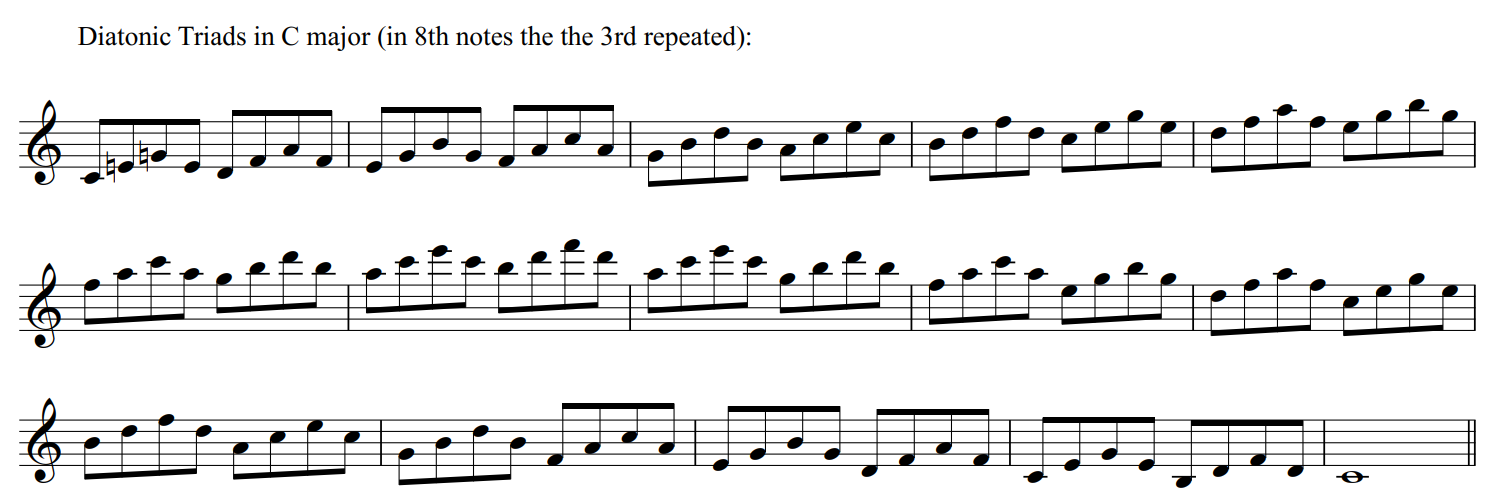
Diatonic Seventh Chord Exercises on the Sax
After getting comfortable with triads, it’s time to switch your focus to the building blocks of jazz harmony—7th chords. For a more in-depth discussion of 7th chords, check out our ultimate guide to 7th chords.

Listen to Jazz Saxophonists! The Best Jazz Saxophonists You Need to Check Out
There is one last thing you must do to guarantee you become the best saxophonist you can be. You need to listen to the jazz greats who have come before you.
In order to develop your own jazz saxophone sound, you need to understand the saxophone landscape in jazz music. There are so many different personalities, styles, and sounds you can use to influence your own playing.
When exploring different jazz saxophonists check out these key players from various jazz music eras (some of these players fit into multiple categories).
Swing Era:
- Johnny Hodges
- Ben Webster
Bebop:
- Charlie Parker
- Sonny Stitt
- Dexter Gordon
Hard Bop:
- Sonny Rollins
- Joe Henderson
- Hank Crawford
- Wayne Shorter
- Hank Mobley
Cool Jazz:
- Paul Desmond
- Gerry Mulligan
- Lee Konitz
- Zoot Sims
- Stan Getz
Free Jazz/Avant-Garde:
- Ornette Coleman
- Rahsaan Roland Kirk
Post-Bop:
- John Coltrane
- Michael Brecker
Fusion/Smooth/Soul Jazz:
- David Sanborn
- Grover Washington Jr.
- Dave Koz
Modern/Contemporary Jazz:
- Joshua Redman
- Chris Potter
- Kamasi Washington
- Miguel Zenón
- Melissa Aldana
- Ravi Coltrane
Overhaul Your Jazz Saxophone Playing. Join The Learn Jazz Standards Inner Circle.
If you found this jazz saxophone beginner’s guide useful and want to dive deeper into jazz saxophone, jazz theory, and improvisational concepts, then check out the Inner Circle.
Members have access to the Jazz Saxophone Accelerator course to help them tackle the technical challenges of the baritone sax, tenor sax, alto sax, and soprano saxophones.
Learn about false fingers, overtones, and multiphonics to take your saxophone playing to the next level.
Become the best jazz saxophonist you can be. Join the Inner Circle.











